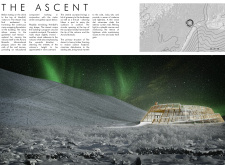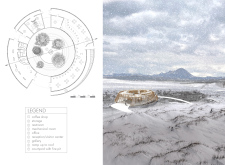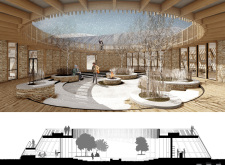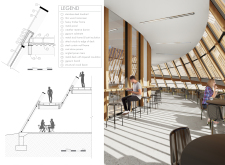5 key facts about this project
The exterior of the building features a combination of natural and industrial materials, including glass, steel, and reclaimed wood. This careful selection supports the project’s sustainability goals while enhancing the visual harmony with the urban landscape. Large windows and sliding glass doors create an interplay of light and shadow, allowing for natural illumination throughout the day while also offering panoramic views of the city. The use of reclaimed wood cladding not only emphasizes eco-conscious design but also provides a warm contrast to the cooler tones of steel and glass.
A notable aspect of the project is its unique approach to modularity. The design employs a modular system that allows for flexibility in configuration, accommodating changes in use over time without significant renovations. This adaptability is a critical response to the evolving needs of urban environments, addressing the challenges posed by fluctuating demographics and market demands. Each module is designed to function independently while contributing to the overall architectural cohesion. This not only maximizes space efficiency but also encourages a sense of community through shared areas and collaborative spaces.
The landscaping integrates biophilic design principles, fostering a connection between occupants and nature. Green roofs and vertical gardens are incorporated throughout the structure, enhancing biodiversity and improving air quality. These elements serve not only an ecological purpose but also provide visual and psychological benefits for the building's occupants. Outdoor terraces and communal rooftops offer spaces for relaxation and social interaction, reinforcing community ties.
Additionally, the project incorporates advanced building technologies to ensure energy efficiency. Solar panels are strategically placed on the roof to generate renewable energy, while smart systems monitor energy usage and environmental conditions. The interior layout promotes natural ventilation and daylighting, decreasing reliance on mechanical systems. These design strategies significantly reduce the building's carbon footprint while also optimizing operational costs.
The architectural plans reveal intricate details that enhance both function and aesthetics. Each level is carefully articulated to facilitate movement and interaction among users. Common spaces are intentionally designed to foster collaboration, with flexible furniture arrangements and open layouts that accommodate various activities.
Exploring the architectural sections offers further insights into how space is utilized effectively. The design integrates both public and private areas, ensuring that occupants feel a sense of ownership and inclusivity. This careful balancing of space addresses the diverse needs of the community it serves, making it a noteworthy example of contemporary urban architecture.
This project stands out in its commitment to sustainability and adaptability, showcasing a thoughtful synthesis of function, form, and ecological responsibility. For a more comprehensive understanding of this architectural design, including detailed architectural plans and sections, readers are encouraged to explore the project's presentation further. By examining these elements, one may appreciate the rich architectural ideas that have informed the design, resulting in a space that is both functional and responsive to the needs of its users.


























